Feasibility Study of Anhydrous Ethanol Production from Sugar Beet
VerifiedAdded on 2023/04/23
|6
|1052
|54
Report
AI Summary
This report presents a feasibility study on the production of anhydrous ethanol from sugar beet. It begins with an introduction highlighting the need for renewable energy sources and the potential of ethanol as a substitute for fossil fuels. The study focuses on the production of ethanol from sugar beet molasses, detailing the fermentation and distillation processes. It includes material and energy balances, calculating the required amount of sugar beet for a plant producing 10,000 m3 of ethanol per year. The report also provides a preliminary flow diagram and discusses hazard identification and cost estimates, referencing relevant studies and concluding that the project could reduce environmental pollution. The report suggests establishing the plant in the southern part of Scania, Sweden, to reduce transportation costs.
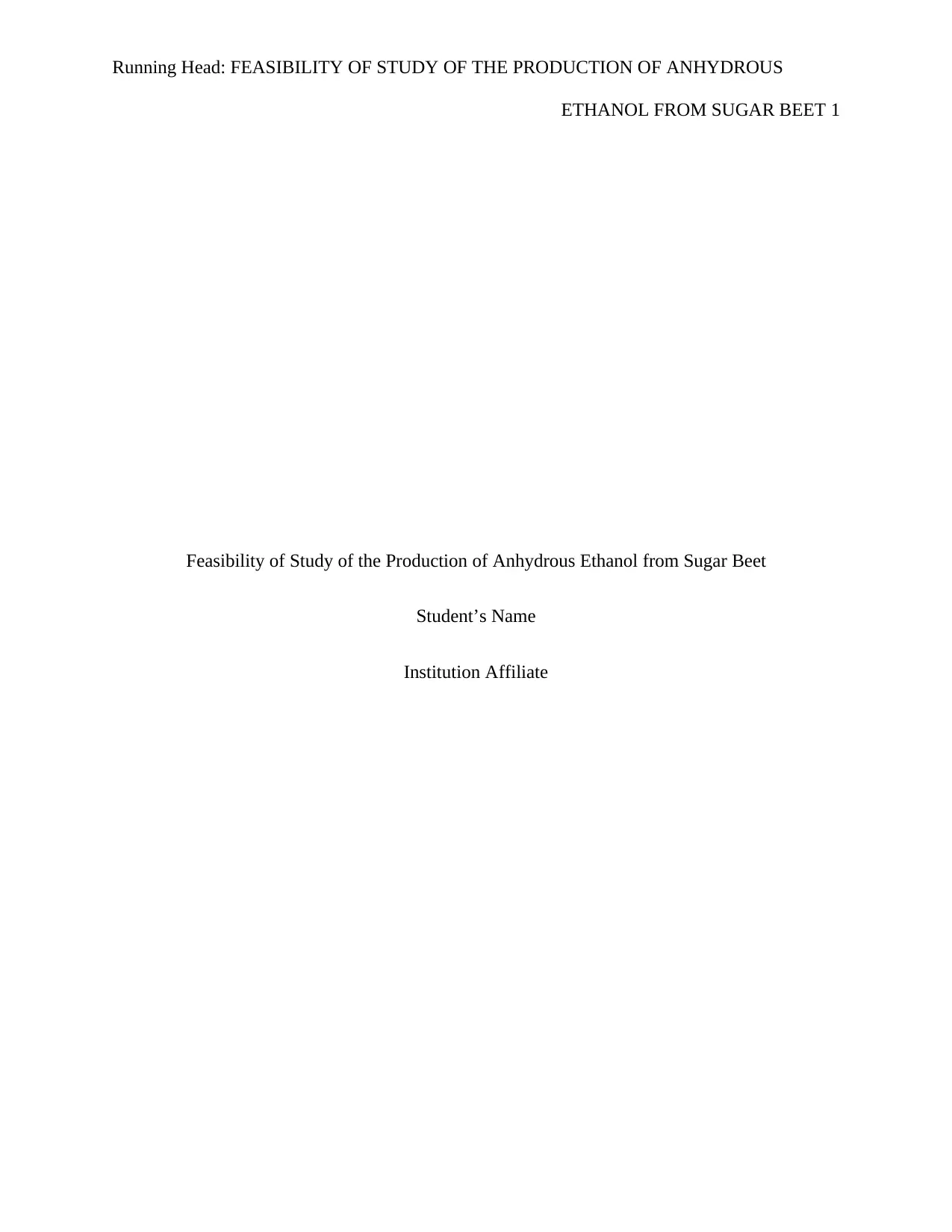
Running Head: FEASIBILITY OF STUDY OF THE PRODUCTION OF ANHYDROUS
ETHANOL FROM SUGAR BEET 1
Feasibility of Study of the Production of Anhydrous Ethanol from Sugar Beet
Student’s Name
Institution Affiliate
ETHANOL FROM SUGAR BEET 1
Feasibility of Study of the Production of Anhydrous Ethanol from Sugar Beet
Student’s Name
Institution Affiliate
Secure Best Marks with AI Grader
Need help grading? Try our AI Grader for instant feedback on your assignments.
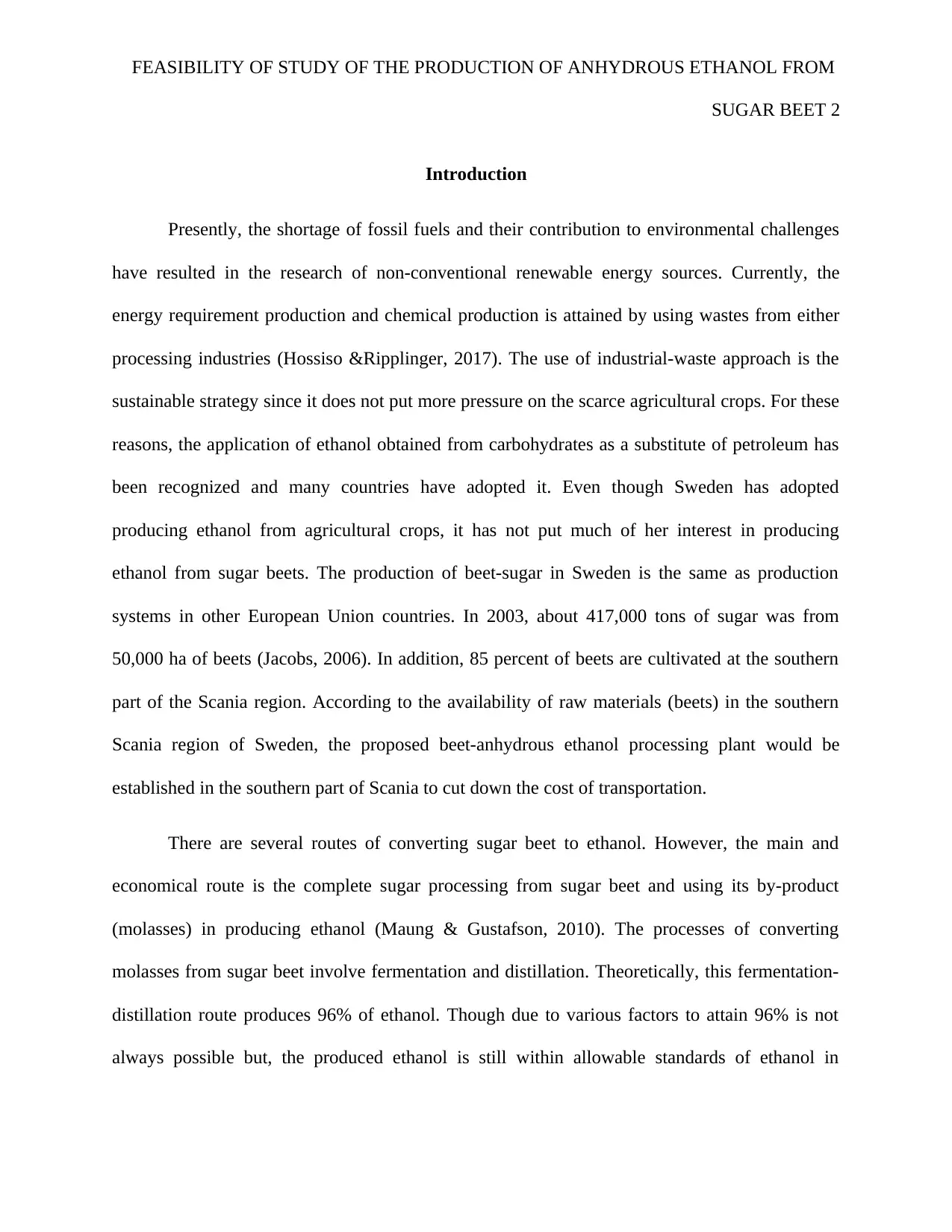
FEASIBILITY OF STUDY OF THE PRODUCTION OF ANHYDROUS ETHANOL FROM
SUGAR BEET 2
Introduction
Presently, the shortage of fossil fuels and their contribution to environmental challenges
have resulted in the research of non-conventional renewable energy sources. Currently, the
energy requirement production and chemical production is attained by using wastes from either
processing industries (Hossiso &Ripplinger, 2017). The use of industrial-waste approach is the
sustainable strategy since it does not put more pressure on the scarce agricultural crops. For these
reasons, the application of ethanol obtained from carbohydrates as a substitute of petroleum has
been recognized and many countries have adopted it. Even though Sweden has adopted
producing ethanol from agricultural crops, it has not put much of her interest in producing
ethanol from sugar beets. The production of beet-sugar in Sweden is the same as production
systems in other European Union countries. In 2003, about 417,000 tons of sugar was from
50,000 ha of beets (Jacobs, 2006). In addition, 85 percent of beets are cultivated at the southern
part of the Scania region. According to the availability of raw materials (beets) in the southern
Scania region of Sweden, the proposed beet-anhydrous ethanol processing plant would be
established in the southern part of Scania to cut down the cost of transportation.
There are several routes of converting sugar beet to ethanol. However, the main and
economical route is the complete sugar processing from sugar beet and using its by-product
(molasses) in producing ethanol (Maung & Gustafson, 2010). The processes of converting
molasses from sugar beet involve fermentation and distillation. Theoretically, this fermentation-
distillation route produces 96% of ethanol. Though due to various factors to attain 96% is not
always possible but, the produced ethanol is still within allowable standards of ethanol in
SUGAR BEET 2
Introduction
Presently, the shortage of fossil fuels and their contribution to environmental challenges
have resulted in the research of non-conventional renewable energy sources. Currently, the
energy requirement production and chemical production is attained by using wastes from either
processing industries (Hossiso &Ripplinger, 2017). The use of industrial-waste approach is the
sustainable strategy since it does not put more pressure on the scarce agricultural crops. For these
reasons, the application of ethanol obtained from carbohydrates as a substitute of petroleum has
been recognized and many countries have adopted it. Even though Sweden has adopted
producing ethanol from agricultural crops, it has not put much of her interest in producing
ethanol from sugar beets. The production of beet-sugar in Sweden is the same as production
systems in other European Union countries. In 2003, about 417,000 tons of sugar was from
50,000 ha of beets (Jacobs, 2006). In addition, 85 percent of beets are cultivated at the southern
part of the Scania region. According to the availability of raw materials (beets) in the southern
Scania region of Sweden, the proposed beet-anhydrous ethanol processing plant would be
established in the southern part of Scania to cut down the cost of transportation.
There are several routes of converting sugar beet to ethanol. However, the main and
economical route is the complete sugar processing from sugar beet and using its by-product
(molasses) in producing ethanol (Maung & Gustafson, 2010). The processes of converting
molasses from sugar beet involve fermentation and distillation. Theoretically, this fermentation-
distillation route produces 96% of ethanol. Though due to various factors to attain 96% is not
always possible but, the produced ethanol is still within allowable standards of ethanol in
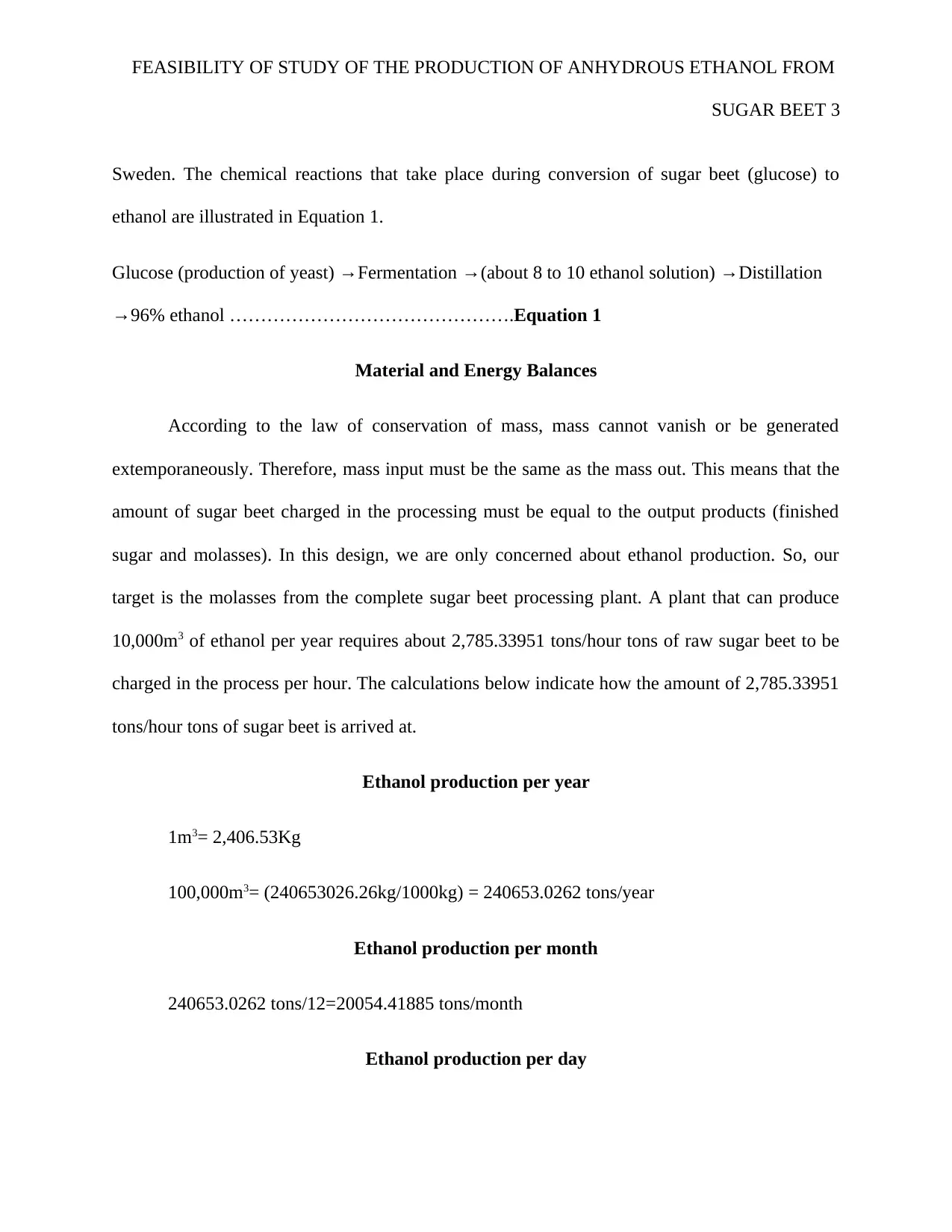
FEASIBILITY OF STUDY OF THE PRODUCTION OF ANHYDROUS ETHANOL FROM
SUGAR BEET 3
Sweden. The chemical reactions that take place during conversion of sugar beet (glucose) to
ethanol are illustrated in Equation 1.
Glucose (production of yeast) →Fermentation →(about 8 to 10 ethanol solution) →Distillation
→96% ethanol ……………………………………….Equation 1
Material and Energy Balances
According to the law of conservation of mass, mass cannot vanish or be generated
extemporaneously. Therefore, mass input must be the same as the mass out. This means that the
amount of sugar beet charged in the processing must be equal to the output products (finished
sugar and molasses). In this design, we are only concerned about ethanol production. So, our
target is the molasses from the complete sugar beet processing plant. A plant that can produce
10,000m3 of ethanol per year requires about 2,785.33951 tons/hour tons of raw sugar beet to be
charged in the process per hour. The calculations below indicate how the amount of 2,785.33951
tons/hour tons of sugar beet is arrived at.
Ethanol production per year
1m3= 2,406.53Kg
100,000m3= (240653026.26kg/1000kg) = 240653.0262 tons/year
Ethanol production per month
240653.0262 tons/12=20054.41885 tons/month
Ethanol production per day
SUGAR BEET 3
Sweden. The chemical reactions that take place during conversion of sugar beet (glucose) to
ethanol are illustrated in Equation 1.
Glucose (production of yeast) →Fermentation →(about 8 to 10 ethanol solution) →Distillation
→96% ethanol ……………………………………….Equation 1
Material and Energy Balances
According to the law of conservation of mass, mass cannot vanish or be generated
extemporaneously. Therefore, mass input must be the same as the mass out. This means that the
amount of sugar beet charged in the processing must be equal to the output products (finished
sugar and molasses). In this design, we are only concerned about ethanol production. So, our
target is the molasses from the complete sugar beet processing plant. A plant that can produce
10,000m3 of ethanol per year requires about 2,785.33951 tons/hour tons of raw sugar beet to be
charged in the process per hour. The calculations below indicate how the amount of 2,785.33951
tons/hour tons of sugar beet is arrived at.
Ethanol production per year
1m3= 2,406.53Kg
100,000m3= (240653026.26kg/1000kg) = 240653.0262 tons/year
Ethanol production per month
240653.0262 tons/12=20054.41885 tons/month
Ethanol production per day
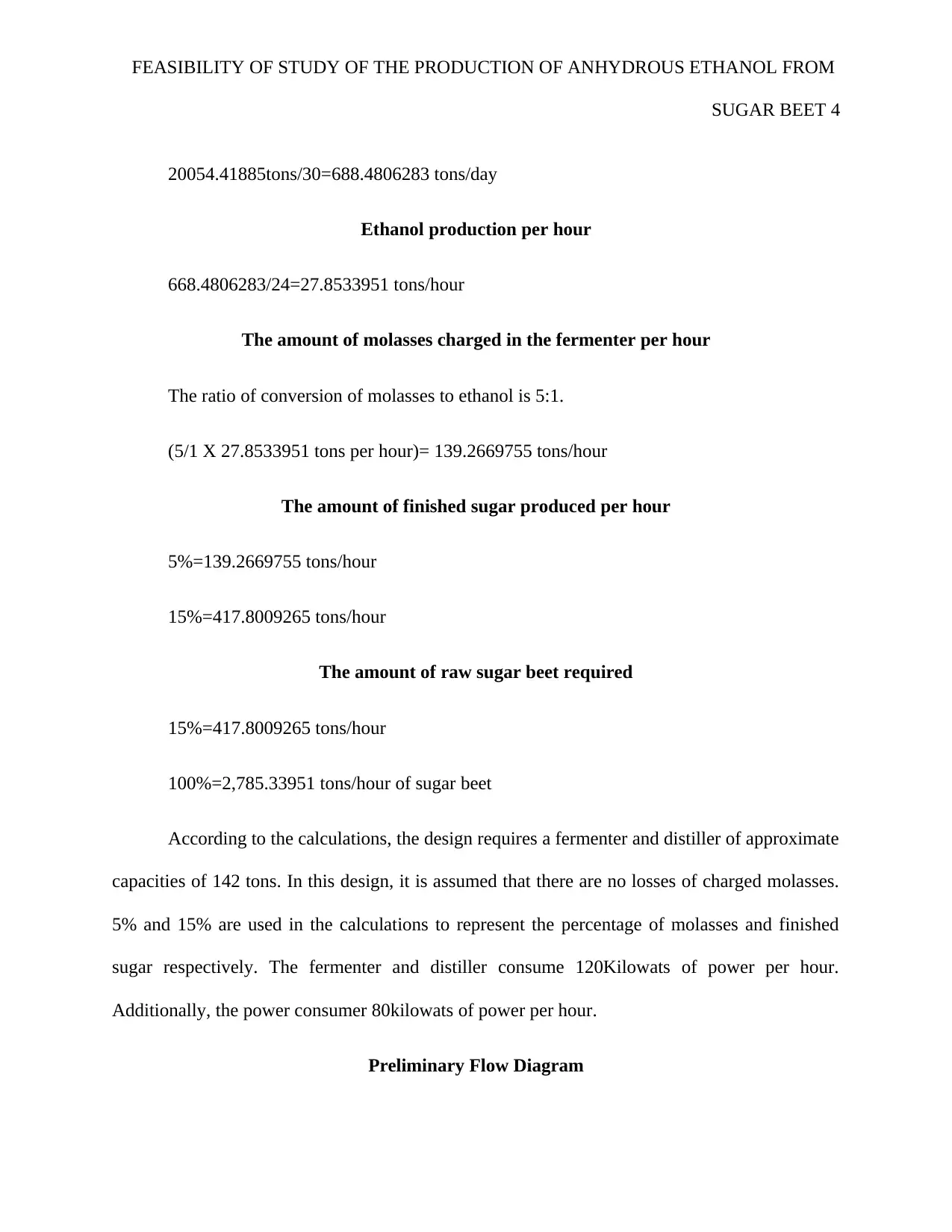
FEASIBILITY OF STUDY OF THE PRODUCTION OF ANHYDROUS ETHANOL FROM
SUGAR BEET 4
20054.41885tons/30=688.4806283 tons/day
Ethanol production per hour
668.4806283/24=27.8533951 tons/hour
The amount of molasses charged in the fermenter per hour
The ratio of conversion of molasses to ethanol is 5:1.
(5/1 X 27.8533951 tons per hour)= 139.2669755 tons/hour
The amount of finished sugar produced per hour
5%=139.2669755 tons/hour
15%=417.8009265 tons/hour
The amount of raw sugar beet required
15%=417.8009265 tons/hour
100%=2,785.33951 tons/hour of sugar beet
According to the calculations, the design requires a fermenter and distiller of approximate
capacities of 142 tons. In this design, it is assumed that there are no losses of charged molasses.
5% and 15% are used in the calculations to represent the percentage of molasses and finished
sugar respectively. The fermenter and distiller consume 120Kilowats of power per hour.
Additionally, the power consumer 80kilowats of power per hour.
Preliminary Flow Diagram
SUGAR BEET 4
20054.41885tons/30=688.4806283 tons/day
Ethanol production per hour
668.4806283/24=27.8533951 tons/hour
The amount of molasses charged in the fermenter per hour
The ratio of conversion of molasses to ethanol is 5:1.
(5/1 X 27.8533951 tons per hour)= 139.2669755 tons/hour
The amount of finished sugar produced per hour
5%=139.2669755 tons/hour
15%=417.8009265 tons/hour
The amount of raw sugar beet required
15%=417.8009265 tons/hour
100%=2,785.33951 tons/hour of sugar beet
According to the calculations, the design requires a fermenter and distiller of approximate
capacities of 142 tons. In this design, it is assumed that there are no losses of charged molasses.
5% and 15% are used in the calculations to represent the percentage of molasses and finished
sugar respectively. The fermenter and distiller consume 120Kilowats of power per hour.
Additionally, the power consumer 80kilowats of power per hour.
Preliminary Flow Diagram
Secure Best Marks with AI Grader
Need help grading? Try our AI Grader for instant feedback on your assignments.
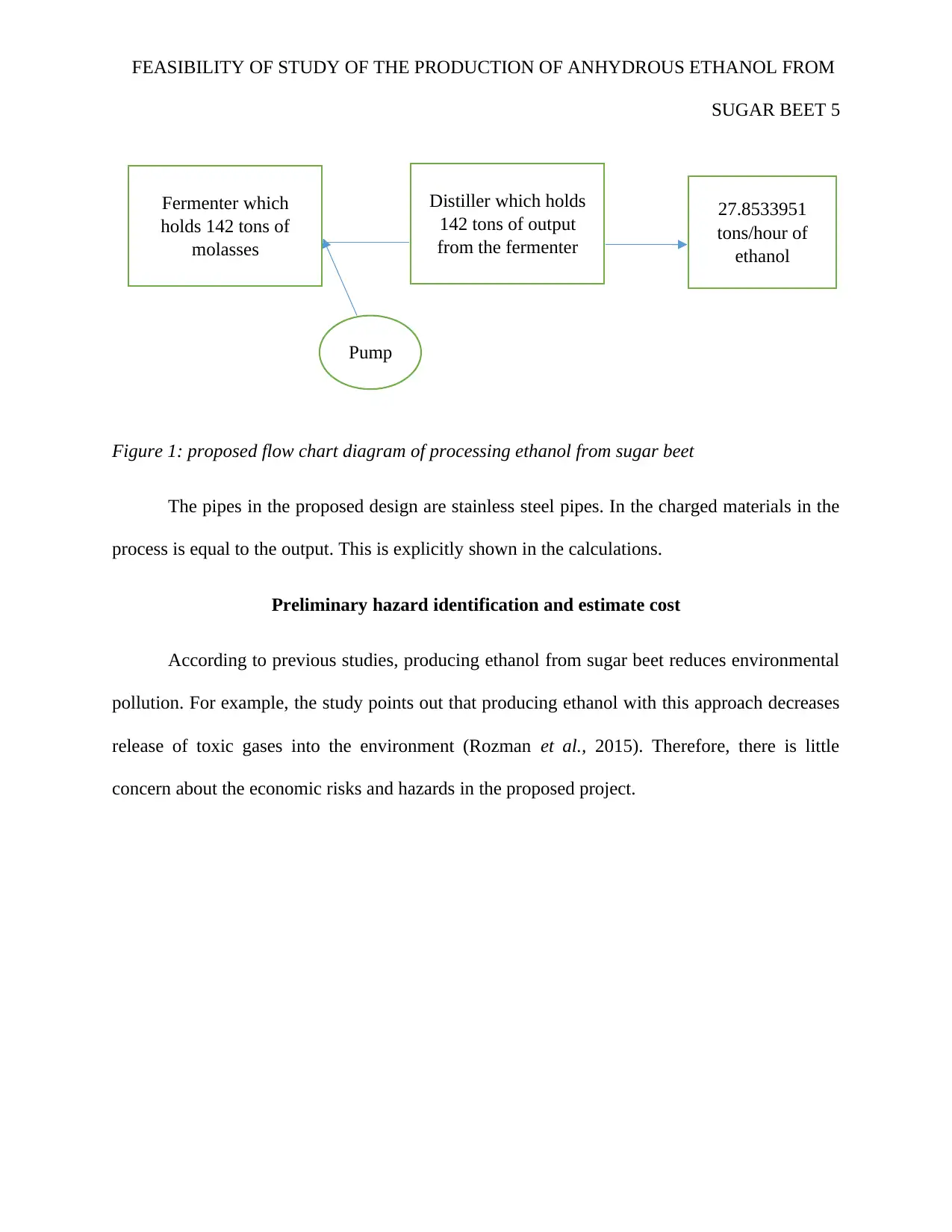
FEASIBILITY OF STUDY OF THE PRODUCTION OF ANHYDROUS ETHANOL FROM
SUGAR BEET 5
Figure 1: proposed flow chart diagram of processing ethanol from sugar beet
The pipes in the proposed design are stainless steel pipes. In the charged materials in the
process is equal to the output. This is explicitly shown in the calculations.
Preliminary hazard identification and estimate cost
According to previous studies, producing ethanol from sugar beet reduces environmental
pollution. For example, the study points out that producing ethanol with this approach decreases
release of toxic gases into the environment (Rozman et al., 2015). Therefore, there is little
concern about the economic risks and hazards in the proposed project.
Fermenter which
holds 142 tons of
molasses
Distiller which holds
142 tons of output
from the fermenter
Pump
27.8533951
tons/hour of
ethanol
SUGAR BEET 5
Figure 1: proposed flow chart diagram of processing ethanol from sugar beet
The pipes in the proposed design are stainless steel pipes. In the charged materials in the
process is equal to the output. This is explicitly shown in the calculations.
Preliminary hazard identification and estimate cost
According to previous studies, producing ethanol from sugar beet reduces environmental
pollution. For example, the study points out that producing ethanol with this approach decreases
release of toxic gases into the environment (Rozman et al., 2015). Therefore, there is little
concern about the economic risks and hazards in the proposed project.
Fermenter which
holds 142 tons of
molasses
Distiller which holds
142 tons of output
from the fermenter
Pump
27.8533951
tons/hour of
ethanol
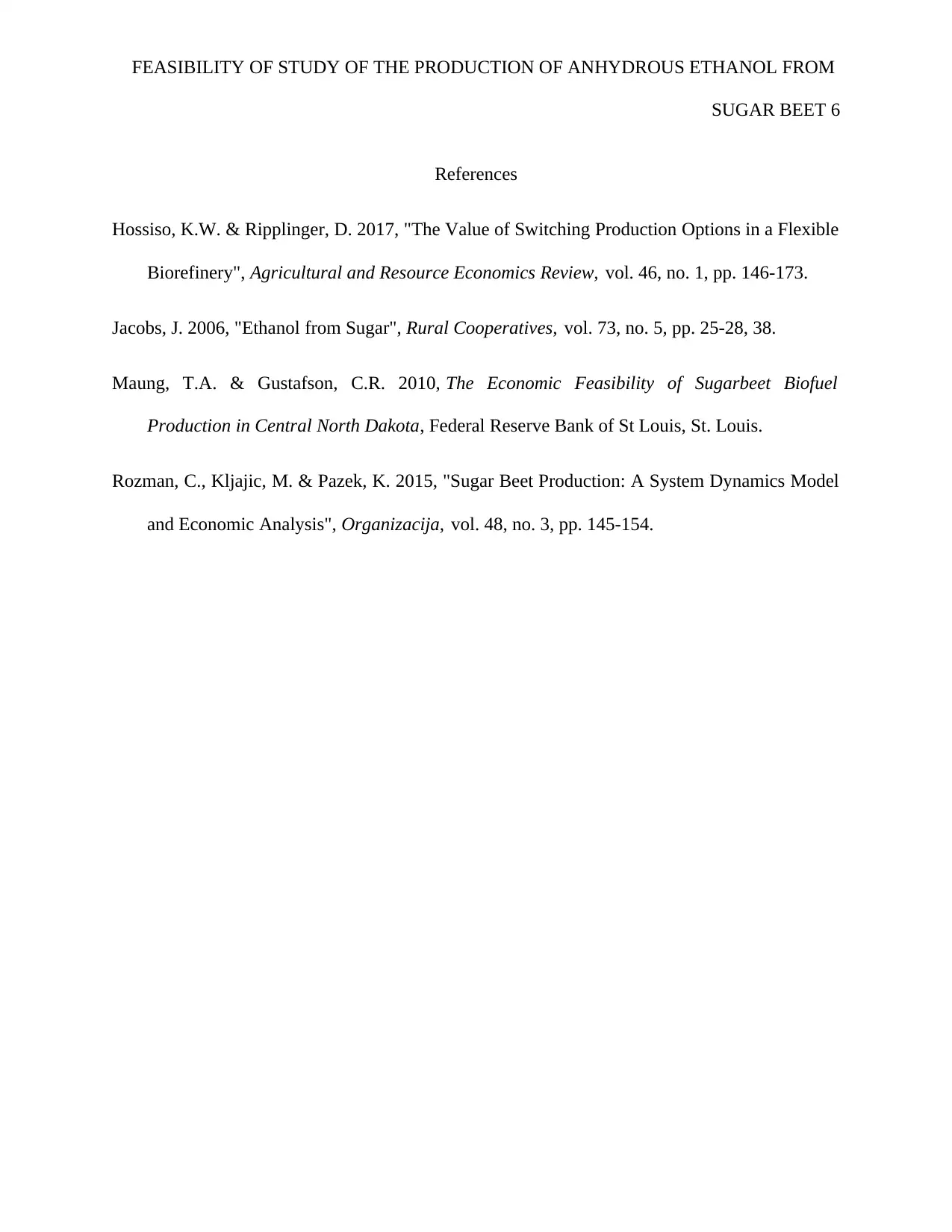
FEASIBILITY OF STUDY OF THE PRODUCTION OF ANHYDROUS ETHANOL FROM
SUGAR BEET 6
References
Hossiso, K.W. & Ripplinger, D. 2017, "The Value of Switching Production Options in a Flexible
Biorefinery", Agricultural and Resource Economics Review, vol. 46, no. 1, pp. 146-173.
Jacobs, J. 2006, "Ethanol from Sugar", Rural Cooperatives, vol. 73, no. 5, pp. 25-28, 38.
Maung, T.A. & Gustafson, C.R. 2010, The Economic Feasibility of Sugarbeet Biofuel
Production in Central North Dakota, Federal Reserve Bank of St Louis, St. Louis.
Rozman, C., Kljajic, M. & Pazek, K. 2015, "Sugar Beet Production: A System Dynamics Model
and Economic Analysis", Organizacija, vol. 48, no. 3, pp. 145-154.
SUGAR BEET 6
References
Hossiso, K.W. & Ripplinger, D. 2017, "The Value of Switching Production Options in a Flexible
Biorefinery", Agricultural and Resource Economics Review, vol. 46, no. 1, pp. 146-173.
Jacobs, J. 2006, "Ethanol from Sugar", Rural Cooperatives, vol. 73, no. 5, pp. 25-28, 38.
Maung, T.A. & Gustafson, C.R. 2010, The Economic Feasibility of Sugarbeet Biofuel
Production in Central North Dakota, Federal Reserve Bank of St Louis, St. Louis.
Rozman, C., Kljajic, M. & Pazek, K. 2015, "Sugar Beet Production: A System Dynamics Model
and Economic Analysis", Organizacija, vol. 48, no. 3, pp. 145-154.
1 out of 6
Your All-in-One AI-Powered Toolkit for Academic Success.
+13062052269
info@desklib.com
Available 24*7 on WhatsApp / Email
![[object Object]](/_next/static/media/star-bottom.7253800d.svg)
Unlock your academic potential
© 2024 | Zucol Services PVT LTD | All rights reserved.